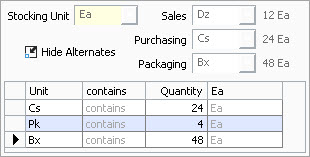What do the Units of Measure in the Product Edit Window mean?
Each product has a Stocking Unit which is the base unit of measure (UOM) for all transactions. Conversions to other UOM are created for use throughout the application. These can then be set as a default Sales, Purchasing, or Packaging unit.
Acctivate supports multiple, related units of measure per product. There are many configuration options for units of measure and there are no limits to the number of units that can be defined. For example, this allows an item stocked by Each to be purchased by Case, sold by Dozen, and packaged/shipped by Box.
For more information, review our training page.
Unit of Measure: Unit of measure is configured in Configuration Manager > Inventory > Unit of Measure


View/Edit Alternates button: When not in edit mode, this button will say View Alternates. When in edit mode, this button will say Edit Alternates.
There can be virtually unlimited multiple related units of measure per product. This button opens a data entry grid for viewing and entering additional related units. To hide this data grid, click the Hide Alternates button.
Stocking Unit
The product stocking unit of measure is used to count the warehouse quantity.
Each product must be stocked in a single unit of measure. This is required since all transactions will be converted to this Stocking Unit for inventory valuation and the Transactions tab of the Product Information window.
All units of measure are available for the Stocking Unit, but the Sales, Purchasing and Packaging Unit drop-downs only contain those related to the Stocking Unit.
NOTE: Once a product has been included in a transaction, users are unable to change the Stocking Unit. For more information on how to accomplish this, see our article on changing the Stocking Unit of Measure.
Product Alternate Unit Quantity
The quantity of Stocking Units contained in a single Alternate Unit often varies. A good example of this is the Each-to-Case quantity. The Case quantity for one item may be 12 Each, while it's 20 Each for another product.
A box will appear to the right of the Alternate Unit (e.g. Purchasing Unit) if the Unit of Measure relationship is Product Specific.
A View Alternates (or Edit Alternates when in edit mode) is also available to view and edit Product Specific unit quantity relationships (factors). Changes to the Alternate Unit quantity only affect new transactions.
Sales
The sales unit of measure relates to the stocking unit of measure. This will be used as the default unit of measure for sales orders. If related units exist (that are defined in the Configuration Manager) they will be in the provided drop-down.
If a related unit is selected that is defined as having a product-specific relationship (the stocking unit quantity varies by product) with the stocking unit, then the field to the left of the unit of measure will allow you to enter a quantity for the related unit in relation to the stocking unit.
Price Unit must be for all prices, which allows you to enter all sales orders in the single Sales Unit, regardless of customers' special pricing.
Purchasing
The purchasing unit of measure relates to the stocking unit of measure. This will be used as the default unit of measure for purchase orders. If related units exist (that are defined in the Configuration Manager) they will be in the provided drop-down.
If a related unit is selected that is defined as having a product-specific relationship (the stocking unit quantity varies by product) with the stocking unit, then the field to the left of the unit of measure will allow you to enter a quantity for the related unit in relation to the stocking unit.
The Purchasing Unit is only used when a Vendor Price (or prior PO) doesn't exist for the item. Acctivate prefers using the Unit from the Vendors tab.Packaging
The packaging unit of measure (used with the Packaging Manager and EDI Manager add-ons) relates to the stocking unit of measure. This will be used as the default unit of measure for packaging. If related units exist (that are defined in the Configuration Manager) they will be in the provided drop-down.
If a related unit is selected that is defined as having a product-specific relationship (the stocking unit quantity varies by product) with the stocking unit, then the field to the left of the unit of measure will allow you to enter a quantity for the related unit in relation to the stocking unit.
The Packaging Unit is used to determine how many cartons should be created when using the Packaging Manager for Standard Pack Cartons.